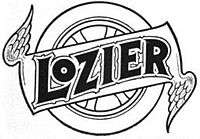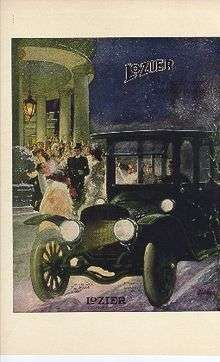Lozier
 | |
| Automobile Manufacturing | |
| Industry | Automotive |
| Genre | Touring cars, limousines |
| Founded | 1900 |
| Founder | Henry Abrahm Lozier |
| Defunct | 1915 |
| Headquarters | Detroit, Michigan, United States |
Area served | United States |
| Products |
Vehicles Automotive parts |

The Lozier Motor Company was a brass era producer of automobiles in the United States of America. The company produced luxury automobiles from 1900 to 1915, with a factory at 3703 Mack Avenue,[1] Detroit, Michigan.
The company was founded in Plattsburgh, New York by Henry Abrahm Lozier, an Indiana-born sewing machine and bicycle manufacturer.
History
After selling his bicycle business, Lozier moved to Plattsburgh to manufacture boat engines. In 1900, he entered the automobile business. At his death in 1903, his son Harry took over the company.
Loziers were top line luxury cars and for a time were the most expensive cars produced in the United States. The 1910 model line featured cars priced between US$4,600 and US$7,750. The same year, a Cadillac could be had for about US$1,600 and a Packard US$3,200. A pre-assembly line Ford Model T of the same year retailed at approximately US$850 (after installing assembly line production a few years later, new Model Ts sold for as little as US$240). The average annual salary in America that year was approximately US$750.
The company was moved to Detroit in 1910. In 1911, a Lozier was entered into the first running of the Indianapolis 500. The car, in the hands of Ralph Mulford, finished second in a controversial scoring decision and many observers felt Mulford's Lozier had actually won the race. On March 19 the same year, Lozier ads claimed, a stock 49 hp (37 kW) model piloted by Teddy Tetzlaff set a world record for 100 mi (160 km) at 1:14:29.[2]
Because of Lozier's limited market niche, the company only produced a few thousand cars during its brief lifespan. Production peaked in the 1912 model year at 600 cars.
The company faced new pressures as more manufacturers entered the market. Frederick C. Chandler, Lozier's top designer, left the company in 1913 and formed the Chandler Motor Company which produced cars similar to the Lozier but at a substantially lower sales price. Chandler took several top company executives with him producing a brain drain from which the company never recovered.
At the 1913 Los Angeles Motordome, however, the company introduced the 88 hp (66 kW) Big Six, with electric headlights, with tourers and roadsters at US$5,000, limousines and landaulettes at US$6,500. It was joined by the 52 hp (40 kW) Light Six Metropolitan, with electric starter and lights; the tourer and runabout were US$3,250, coupe US$3,850, and limousine US$4,450.[1][3]
Lozier tried to expand into the mid priced car market and in 1914 offered a four-cylinder car priced at US$2,000. It faced competition from the US$2000 Enger 40,[4] the cheaper FAL at US$1750,[4] the US$1600 Oakland 40[5] and Cole Four at US$1925,[6] and Western's US$500 Gale Model A roadster,[7] to name just a few. The new four was not a sales success and company finances continued to falter. After a failed attempt to merge with Ford Motor Company, the company declared bankruptcy in 1915.
Advertisements
 The Lozier Motor Company of New York City – 1905 |
 Image from a 1912 advertisement for a Lozier touring car priced at $5,000. |
Notes
Sources
- Clymer, Floyd. Treasury of Early American Automobiles, 1877–1925. New York: Bonanza Books, 1950.
- Standard Catalogue of American Cars, 2nd Edition, editors Beverly Rae Kimes and Henry Austin Clark, jr., Krause Publications, Iola WI 54990 ISBN 0-87341-111-0.
See also
External links
| Wikimedia Commons has media related to Lozier vehicles. |
- The Lozier at conceptcarz
- racepictures by Photographer James Walter Collinge 3.,4., 9. picture: Teddy Tetzlaff in a Lozier.